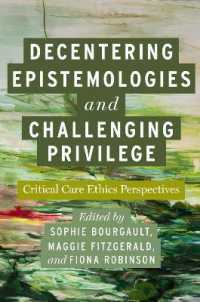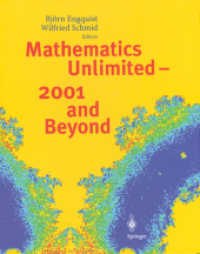Full Description
This book sets out to historicise our understanding of contemporary trends by studying the long relationship between science, food and drink marketing and the promotion of healthy lifestyles. It aims to bring together contemporary and historical research from a multimodal perspective, considering how scientific discourse and ideas about health and nutrition are channelled through visual and material culture.
Using examples of advertisements, commercials and posters, the 16 chapters in this book will foster a cross-disciplinary and cross-temporal dialogue, uncovering links between past and present ways that manufacturers have capitalised upon scientific innovations to create new products or rebrand existing products and employed science to make claims about health and nutrition. They will, thus, demonstrate the continuity of science in food and drink marketing—even if fundamental ideas of nutrition have evolved over time. The book provides crucial new insights into the significance of the late nineteenth and early twentieth centuries as a period of innovation in food and drink marketing and showcasing how many of the marketing strategies employed today, in fact, have a far broader historical trajectory.
It will be of great interest to students and scholars of Critical Food Studies, Media and Communication Studies, History of Science and Medicine and Cultural Studies, as well as nutritionists, dieticians, sportspeople, in addition to policymakers and practitioners working in the area of food and drink marketing.
Contents
Introduction: Selling Healthy Lifestyles with Science
(Göran Eriksson and Lauren Alex O'Hagan)
From Foods to Nutrients: 150 Years of Modern Nutrition Science
(Lauren Alex O'Hagan and Göran Eriksson)
SECTION 1: FOOD, HEALTHY BODIES AND NUTRITIONAL ADVICE
Chapter 1 - Vim, Vigour and Vitality: Physical Culture Marketing and the Promise of a Better Life (Conor Heffernan)
Chapter 2 - Multimodal Representations of Health and Science in Danish Advertisements for Dairy Products and Plant-Based Alternatives: A Diachronic Study (Iben Bredahl Jessen)
Chapter 3 - Consumer Activism, Ultra-Processed Food Marketing and the Meaning of Healthy Eating in Mexico: A Diachronic Study (Pilar Zazueta)
Chapter 4 - A Better Way to Start the Day: Pseudoscience, Health and Synthetic Personalisation in Breakfast Cereal Packaging (Angela Smith)
SECTION 2: DRINKS AS ELIXIRS OF HEALTH
Chapter 5 - Best for Babies? Powdered Milk and Scientific Discourse in Early Twentieth-Century China (Lo Shuk Ying)
Chapter 6 - "The Great Natural Health Drink of Our Time": Health, Gender and Nutrition in British Advertisements for Ribena Blackcurrant Drink (Daniel Ewers)
Chapter 7 - A Cheap and Easy Way to Health: Advertising Coffee Substitutes in Sweden, 1870-1914 (Leif Runefelt)
Chapter 8 - "Unveil Your Inner Youth": Science, Gender and Anti-Ageing Milk Marketing in a Chinese Society (Veronica Sau-wa Mak)
SECTION 3: PROMOTING 'PURE' AND 'AUTHENTIC' FOODS
Chapter 9 - Selling Motherhood Through Science: Advertisements for Dalda Cooking Oil in India, 1940s to the Present (Saurabh Mishra)
Chapter 10 - The Rhetoric of Unadulterated Wholemeal: Thomas Allinson and the Natural Food Company, 1892-1918 (Amber Hinde)
Chapter 11 - Between Science and Tradition: Nutrition Epistemologies and Extractionist Logics in Chia Seed Development and Marketing (Jessica Loyer)
SECTION 4: FOOD AND EMERGING TECHNOLOGIES
Chapter 12 - "The Triumph of the New Over the Old": Electric Restaurants, Health and Modernity (Lucy Jane Santos)
Chapter 13 - Bridging the Gap from the Petri Dish to Natural, Healthy Meat: An Insight into Marketing Communications for Cultured Meat (Andreja Vezovnik)
Afterword: A Transhistorical Semiotics of Food Marketing
(Caroline Tagg)








